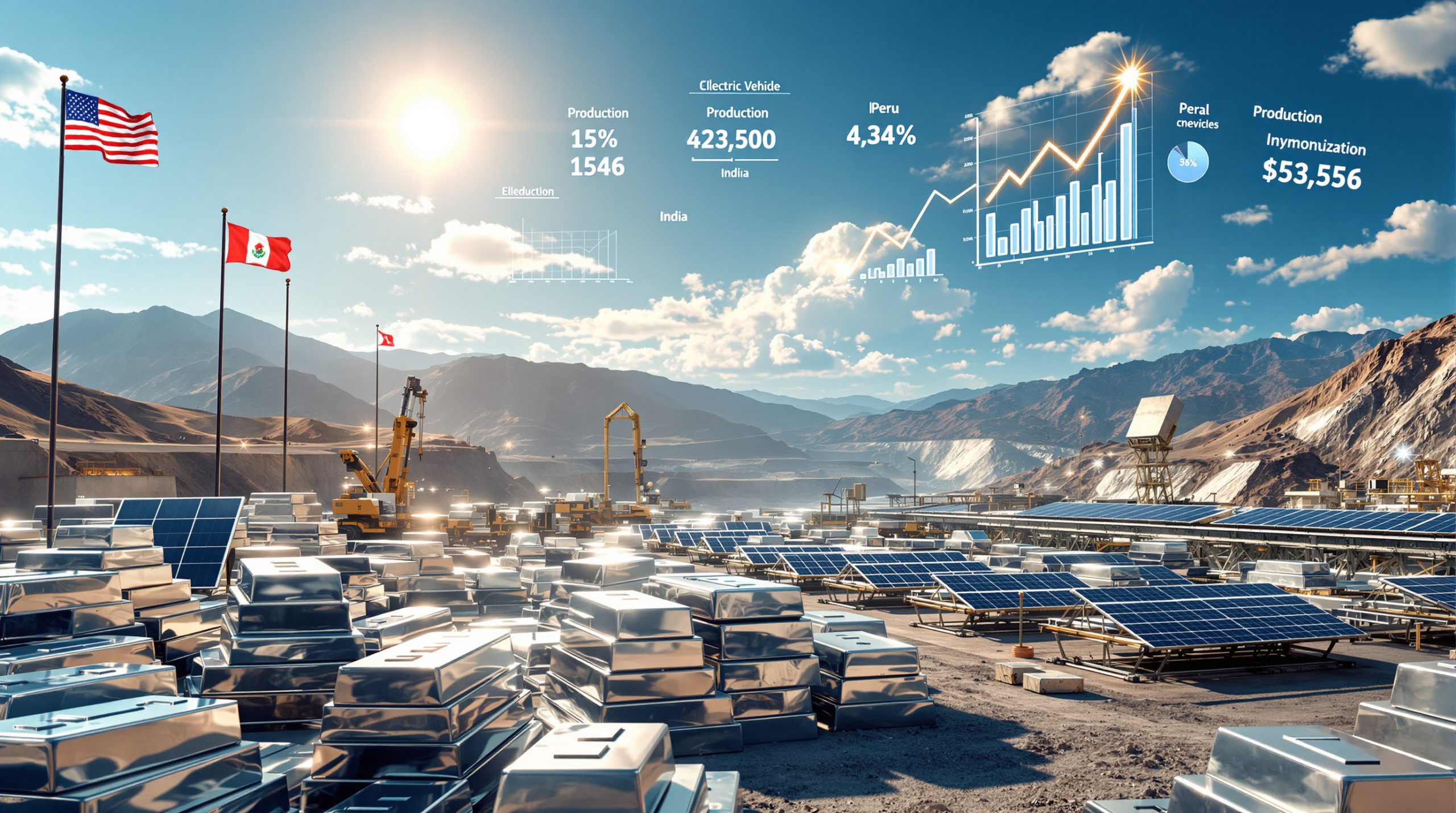The global silver production landscape underwent a significant transformation in 2025, driven by an unprecedented surge in industrial demand. This shift prompted mining operations to accelerate output across multiple regions, as the silver market faced mounting pressures to optimize production strategies. At the forefront of this industrial consumption surge was the photovoltaic sector, which required substantial increases in silver production to meet the growing demands of solar panel manufacturing.
Key Drivers of Industrial Demand
Photovoltaic Cell Manufacturing
Solar panel manufacturing emerged as the dominant force behind the industrial consumption of silver. Each solar panel requires between 10 to 20 grams of silver for conductive pastes, and with global installations reaching record levels, the demand for silver in this sector skyrocketed. Government incentives and cost competitiveness further fueled this growth, making solar energy a cornerstone of renewable energy strategies worldwide.
Electric Vehicles and Advanced Electronics
The electric vehicle (EV) industry also contributed significantly to silver demand. Battery technologies and charging infrastructure require high-conductivity materials, with silver being a preferred choice due to its superior electrical properties. Additionally, advancements in electronics manufacturing, driven by rapid technological innovation, further expanded silver requirements. Renewable energy applications beyond solar panels, including wind turbines and energy storage technologies, added to the growing industrial consumption patterns.
Regional Production Leadership Drives Global Supply Growth
North American Operations Spearhead Expansion Efforts
In North America, mining operations played a crucial role in increasing global silver production through systematic efficiency improvements and strategic infrastructure investments. The Galena Complex in Idaho exemplified this operational excellence, achieving a remarkable 765,000 ounces of silver production in Q3 2025—a 98% increase compared to the same period in 2024. Operational improvements, such as enhanced underground development rates and infrastructure upgrades, were pivotal in this success.
International Mining Regions Contribute to Supply Growth
Peru and Mexico continued to support global silver production through operational expansions and technological advancements. Peru, historically one of the largest silver producers, maintained its output through systematic capacity enhancements. Meanwhile, Mexico’s mining operations, particularly the Cosalá Operations in Sinaloa, demonstrated production improvements by transitioning into higher-grade mining areas, thereby supporting operational efficiency.
Operational Excellence Enables Sustainable Production Increases
Modern mining operations achieved silver production increases not merely by expanding mining volumes but through advanced extraction methodologies. The implementation of digital monitoring systems optimized production workflows, while automated equipment reduced operational costs and improved safety metrics. Facilities like Galena adopted long hole stoping methods, enhancing flexibility in ore extraction and potentially improving recovery rates.
Technological Improvements Supporting Production Growth
Advanced Ore Processing Systems: Improved metal recovery rates.
Automated Mining Equipment: Reduced operational variability.
Digital Workflow Optimization Systems: Maximized productivity.
Infrastructure Upgrades: Increased material handling capacity.
Fleet Modernization Programs: Enhanced equipment reliability.
Byproduct Optimization Strategies Enhance Economic Returns
Multi-metal recovery operations maximized silver extraction while capturing valuable byproducts such as copper, lead, and antimony. This approach not only improved overall project economics but also provided revenue diversification, supporting continued operational investments. By integrating silver recovery processes into lead and zinc mining operations, companies recognized the value of comprehensive metal recovery from processed ore.
Production Growth Addresses Critical Supply Constraints
Despite production improvements, a structural supply deficit in silver markets persisted through 2025. Industrial demand growth consistently outpaced mining capacity expansions, with industrial consumption now representing 81% of total mined silver. This created sustained pressure on available supplies, as investment demand competed with industrial consumption for limited silver resources.
Supply-Demand Dynamic
Factor
2025 Impact
Industrial Consumption Growth
81% of total mined silver
Investment Demand Surge
Strategic stockpiling activity
Byproduct Supply Limitations
Limited supply elasticity
Recycling Contributions
Relatively stable input
The byproduct nature of silver production limited supply responsiveness to price signals, as most silver originates from copper, lead, zinc, and gold mining operations. This structural characteristic created supply inelasticity, supporting sustained pricing levels while encouraging existing operations to maximize silver recovery rates.
Investment Performance Metrics Reflect Production Success
Mining Company Financial Improvements
The increase in silver production translated into improved financial performance for specialized mining companies. Companies with significant silver exposure experienced margin expansion as higher volumes spread fixed operational costs across increased production. For instance, Americas Gold and Silver maintained a cash balance of $39 million as of September 30, 2025, with an additional $50 million available through undrawn credit facilities.
Strategic Metal Value Recognition
The classification of antimony as a critical material enhanced the strategic value proposition for silver producers with co-product capabilities. Partnerships with technology sector companies provided revenue stability through multi-year purchasing agreements, recognizing silver’s essential role in advanced manufacturing processes.
Production Limitations and Future Challenges
Regulatory and Environmental Constraints Impact Growth
Permitting delays extended project development timelines across multiple jurisdictions, limiting the ability of new operations to contribute to silver production increases in the near term. Environmental compliance requirements increased operational expenses, while community relations considerations affected project approval processes.
Geological and Economic Realities Constrain Expansion
Declining ore grades at mature mining operations required higher capital investment to maintain production levels. Additionally, remote deposit locations demanded substantial upfront investment in transportation and processing infrastructure.
What Role Does Silver Play in Energy Transition?
Renewable energy infrastructure development created sustained demand growth that supported continued investment in silver production initiatives. Silver became increasingly critical as solar panel manufacturing consumed increasing quantities through global installation acceleration. The role of silver in energy transition applications, such as photovoltaic cells and energy storage technologies, underscores its importance in achieving renewable energy objectives.
How Should Investors Evaluate Silver Producers?
Operational Performance Assessment
Investors should analyze production growth rates relative to industry benchmarks while assessing cost management effectiveness and operational efficiency improvements. Key metrics include reserve replacement ratios, cash flow generation capacity, and production growth sustainability.
Financial Strength Indicators for Growth Sustainability
Capital allocation efficiency for growth investments determines whether companies can sustain silver production increases without compromising financial stability. Key investment evaluation metrics include production growth sustainability, reserve quality, byproduct contribution stability, and management track record in operational optimization.
Market Price Dynamics and Production Impact
Silver production increases provided temporary supply relief that moderated price volatility, while sustained demand growth continued supporting price levels above production cost thresholds. Currency fluctuations affected international trade pricing, creating regional variations in production economics.
Market Price Support Factors
Industrial consumption growth outpacing supply additions
Strategic stockpiling by governments and institutions
Limited supply elasticity from byproduct nature
Infrastructure investment in renewable energy
Want to Capitalise on Silver Market Opportunities?
Discovery Alert’s proprietary Discovery IQ model delivers instant notifications when ASX-listed silver miners announce significant discoveries, enabling investors to identify actionable opportunities ahead of the broader market. Explore how major mineral discoveries have historically generated substantial returns, and begin your 30-day free trial today to secure your market-leading advantage.
The silver production increase observed in 2025 reflects operational optimization success rather than a fundamental resolution of supply-demand imbalances. Long-term investors should evaluate companies based on sustainable operational improvements and strategic positioning rather than short-term production acceleration that may not represent permanent capacity additions.




